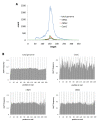Distinct influences of tandem repeats and retrotransposons on CENH3 nucleosome positioning
- PMID: 21352520
- PMCID: PMC3053214
- DOI: 10.1186/1756-8935-4-3
Distinct influences of tandem repeats and retrotransposons on CENH3 nucleosome positioning
Abstract
Background: Unique structural characteristics of centromere chromatin enable it to support assembly of the kinetochore and its associated tensions. The histone H3 variant CENH3 (centromeric histone H3) is viewed as the key element of centromere chromatin and its interaction with centromere DNA is epigenetic in that its localization to centromeres is not sequence-dependent.
Results: In order to investigate what influence the DNA sequence exerts on CENH3 chromatin structure, we examined CENH3 nucleosome footprints on maize centromere DNA. We found a predominant average nucleosome spacing pattern of roughly 190-bp intervals, which was also the dominant arrangement for nucleosomes genome-wide. For CENH3-containing nucleosomes, distinct modes of nucleosome positioning were evident within that general spacing constraint. Over arrays of the major ~156-bp centromeric satellite sequence (tandem repeat) CentC, nucleosomes were not positioned in register with CentC monomers but in conformity with a striking ~10-bp periodicity of AA/TT dimers within the sequence. In contrast, nucleosomes on a class of centromeric retrotransposon (CRM2) lacked a detectable AA/TT periodicity but exhibited tightly phased positioning.
Conclusions: These data support a model in which general chromatin factors independent of both DNA sequence and CENH3 enforce roughly uniform centromeric nucleosome spacing while allowing flexibility in the mode in which nucleosomes are positioned. In the case of tandem repeat DNA, the natural bending effects related to AA/TT periodicity produce an energetically-favourable arrangement consistent with conformationally rigid nucleosomes and stable chromatin at centromeres.
Figures





Similar articles
-
Gene Expression and Chromatin Modifications Associated with Maize Centromeres.G3 (Bethesda). 2015 Nov 12;6(1):183-92. doi: 10.1534/g3.115.022764. G3 (Bethesda). 2015. PMID: 26564952 Free PMC article.
-
The CentO satellite confers translational and rotational phasing on cenH3 nucleosomes in rice centromeres.Proc Natl Acad Sci U S A. 2013 Dec 10;110(50):E4875-83. doi: 10.1073/pnas.1319548110. Epub 2013 Nov 4. Proc Natl Acad Sci U S A. 2013. PMID: 24191062 Free PMC article.
-
Centromeric retroelements and satellites interact with maize kinetochore protein CENH3.Plant Cell. 2002 Nov;14(11):2825-36. doi: 10.1105/tpc.006106. Plant Cell. 2002. PMID: 12417704 Free PMC article.
-
Epigenetic inheritance of centromeres.Cold Spring Harb Symp Quant Biol. 2010;75:51-60. doi: 10.1101/sqb.2010.75.001. Epub 2010 Nov 3. Cold Spring Harb Symp Quant Biol. 2010. PMID: 21047902 Review.
-
Structure, dynamics, and evolution of centromeric nucleosomes.Proc Natl Acad Sci U S A. 2007 Oct 9;104(41):15974-81. doi: 10.1073/pnas.0707648104. Epub 2007 Sep 24. Proc Natl Acad Sci U S A. 2007. PMID: 17893333 Free PMC article. Review.
Cited by
-
Comparing DNA replication programs reveals large timing shifts at centromeres of endocycling cells in maize roots.PLoS Genet. 2020 Oct 14;16(10):e1008623. doi: 10.1371/journal.pgen.1008623. eCollection 2020 Oct. PLoS Genet. 2020. PMID: 33052904 Free PMC article.
-
Tripartite organization of centromeric chromatin in budding yeast.Proc Natl Acad Sci U S A. 2012 Jan 3;109(1):243-8. doi: 10.1073/pnas.1118898109. Epub 2011 Dec 19. Proc Natl Acad Sci U S A. 2012. PMID: 22184235 Free PMC article.
-
Comparative analysis of tandem repeats from hundreds of species reveals unique insights into centromere evolution.Genome Biol. 2013 Jan 30;14(1):R10. doi: 10.1186/gb-2013-14-1-r10. Genome Biol. 2013. PMID: 23363705 Free PMC article.
-
Changes in nucleosome position at transcriptional start sites of specific genes in Zea mays mediator of paramutation1 mutants.Epigenetics. 2013 Apr;8(4):398-408. doi: 10.4161/epi.24199. Epub 2013 Mar 28. Epigenetics. 2013. PMID: 23538550 Free PMC article.
-
Centromere Satellite Repeats Have Undergone Rapid Changes in Polyploid Wheat Subgenomes.Plant Cell. 2019 Sep;31(9):2035-2051. doi: 10.1105/tpc.19.00133. Epub 2019 Jul 16. Plant Cell. 2019. PMID: 31311836 Free PMC article.
References
-
- Baker R, Fitzgerald-Hayes M, O'Brien T. Purification of the yeast centromere binding protein CP1 and a mutational analysis of its binding site. J Biol Chem. 1989;264:10843–10850. - PubMed
LinkOut - more resources
Full Text Sources
Other Literature Sources

